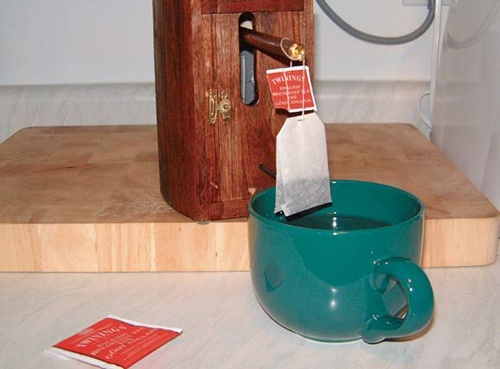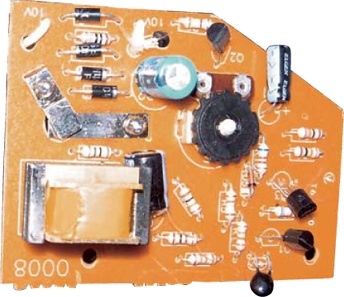Perfect brew by the clock. By Johnathan Nightingale
I didn’t used to care about tea timing. In general, I have found that I can prepare tea of adequate quality by simply leaving the teabag in for “a while.” Recently, though, I was persuaded to begin timing and have been convinced that doing so yields a better and more consistent brew. Conventional tea timers have a common failing though, be they hourglass, mechanical, or, in my case, Palm: they require user intervention. At work, I inevitably became distracted by a conversation or got called away to fix something only to return to a patiently beeping timer and some very overdone tea. What I needed was a timer that could remove the teabag on its own.
I found my salvation in a toaster. A toaster is, after all, an easily obtainable and very cheap device that has, at its core, a variable timer controlling a mechanical lifting arm. Most modern toasters use a simple electronic circuit: when the lever is depressed, current flows to the heating elements and to an electromagnet. The electromagnet holds the lever down against the tension of a spring in the handle. While the toast is toasting, a trickle of current flows into a capacitor at a rate controlled by the “darkness” dial, which is nothing more than a variable resistor or “rheostat.” When the capacitor is filled, the electromagnet disconnects, the lever pops back up, and current is cut to the heating coils. With all this work already done for us, a basic ability to solder and some simple parts should be all that’s needed for this project.
To begin, take the toaster apart. As you remove the front panel, you will see the various components described above: the arm, including a metal tab that the electromagnet grabs; a switch that the arm depresses allowing current to flow; and a circuit board with the electromagnet and rheostat (connected to the toaster’s darkness dial). The toaster’s frame and the heating coils can be discarded, but this is easier said than done: my toaster was built like a tank. A Dremel cutting wheel, tin snips, or some other metal cutting tool will help here.
Note
Only one style of toaster will work for this project. Here’s a simple thrift-store test: push the handle down with the toaster unplugged. If it stays down, you have the wrong kind of toaster — an electromagnetic toaster (the kind you want) will pop back up immediately if no power is flowing to the magnet.
Of course, we don’t want to have to plug this into the wall. The vast majority of a toaster’s energy consumption goes into generating heat in the toasting coils. We don’t want that and neither does the circuit board; it’s counting on having most of the voltage dropped by the heaters. Your circuit board will likely be stamped with something like “10V”; regardless of the appliance voltage, the circuit wants to receive no more than 10V. Since most people like tea to steep a little longer than they like toast to toast, a 9V battery will work well here — the lower voltage will slow the rate at which the capacitor charges, and that’s just fine. The problem of how to convert the toaster from alternating current (wall socket) to direct current (battery) is also solved: the toaster circuit contains a bridge rectifier (a simple circuit for converting AC to DC.) Our DC battery will pass straight through, unaltered.
Putting it all together is easier if you can find a suitable container; I used an unfinished wood box from a local craft store. Cut most of the original power cord, attached to the lever switch, and solder the ends to a 9V battery holder. Solder the other lines from the lever switch to the power leads on the circuit board — thanks to the bridge rectifier, polarity doesn’t matter. Now arrange the pieces in your box as they were in the toaster. For the arm, I used a wooden dowel with a brass hook. To make a cup of tea, tie the teabag onto the hook, push the lever down to immerse the tea bag, and place your trust in the machine.
As the battery runs down, the timer will slow even more, but not to worry. By the time the battery gets that low, the voltage will have dropped low enough that the electromagnet no longer holds. I estimate that a regular 600mAh battery should be good for at least 8 hours runtime, about 80-100 cups for a 5-minute steeper.
Johnathan Nightingale is an IBM coder by day, reality hacker by night, and habitual over-thinker.

